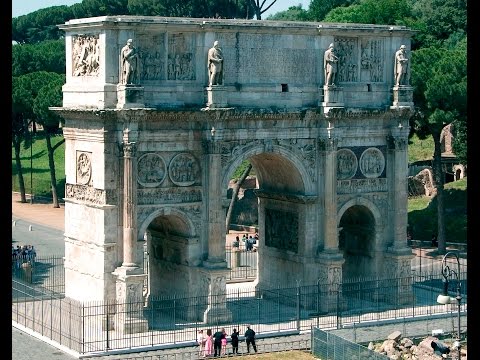Now, we see arches everywhere on our travels and in our lives—some so discreet that you hardly notice them but others so impressive, they will take your breath away. Arches, both made by man and by nature, truly deserve our attention! Here is a list of 10 travel experiences featuring awe-inspiring arches.
10 Delicate Arch National Park, Utah
There is no shortage of arches to be seen in Delicate Arch National Park, Utah. It is the location of the world’s densest concentration of arches, with over 2,000 of them located throughout the park. Many of them are made out of the stunning, red-hued rocks of the region and have been slowly sculpted by millions of years of weather erosion. Amazingly, the arches are prevalent throughout the park due to the sandstone being strong enough to hold their weight. Yet they are soft enough to be easily eroded by water, wind, and gravity because of the entrenched river systems that carve their way through the bedrock in the region. These factors produce ideal conditions for the creation of arches which have existed for a vast period of time, but in terms of the earth’s geological timeline, only for a blink of an eye One of the most recognized arches in Delicate Arch National Park is its namesake arch—Delicate Arch. At 16 meters (52 feet), this tall freestanding arch has been given the nicknames “Cowboy Chaps” and “Old Maid’s Bloomers.” It was first called “Delicate” in a 1934 article by the Arches National Monument Scientific Expedition, which described it as “the most delicately chiseled arch in the entire area.”[1]
9 The Gateway Arch, St. Louis, Missouri
Love it or hate it, The Gateway Arch in St. Louis, Missouri, is an iconic, one-of-a-kind arch. The impressive stainless steel landmark takes its name—Gateway Arch—from the important role St. Louis played as the “Gateway to the West” during the westward expansion of the United States in the 19th century. Representing a doorway to the western part of the country, it’s the tallest monument in the country, measuring a stunning 192 meters (630 feet) tall and equal in its width. You can even take a thrilling—and claustrophobic—four-minute tram ride to the viewing platform at the top of the arch, which offers views of the city and surrounding rivers and parks. Crazy stunt people seem to be drawn to the Gateway Arch—people have tried climbing up the arch, jumping off it, and parachuting onto it. And it never ends well for them, as they usually end up dead or in prison.[2]
8 Colossal Iceberg Arches
To see a majestic iceberg on its final path just before melting into the sea is one of nature’s most spectacular sights. And if that iceberg takes on the shape of an arch—you will have hit the glacial jackpot. An iceberg is a compact slab of 10,000 years of packed snow and ice that breaks off ice-cap glaciers in the extreme north or south of the planet. From the time it breaks off, it begins its seaward journey. These glacier chunks come in many shapes and sizes, forming blocks or wedges, but to see one of these colossal, floating icebergs in the form of an arch is a magnificent sight. These arches are formed when the blocks of floating ice are exposed to wind and seawater, melting away the inner parts and leaving the remaining outer edges of the iceberg to create an amazing bridge-like shape. For the best chances of seeing an ice arch, make spring travel plans to Argentina or Patagonia, Chile, in the south or Greenland, Iceland, or Alaska in the north. Or head over to Iceberg Alley in Newfoundland and Labrador, where anywhere from 400 to 800 icebergs float by every year in the springtime. While you are there, try a beer made with “bergie bits“—that is, beer made from pure iceberg (glacier) water.[3]
7 The Eerie Arches of Convento Do Carmo, Lisbon, Portugal
A massive 9-point magnitude earthquake hit Lisbon, Portugal, on November 1, 1755, leaving as many as 50,000 people dead and most of the city in ruins. The roof and nave of the Convento do Carmo, a 13th-century gothic cathedral, also collapsed on parishioners who were gathered for a mass celebrating All Saints Day. However, the eerie skeleton of the cathedral’s arches remained. The ruins of the Convento do Carmo and its open-to-the-sky wishbone-shaped arches still, even today, serve as a memorial and museum of the devastating series of events caused by the earthquake of 1755. The eye-catching arches make for a photographer’s dream, casting dramatic light and shadows on the ruins of the cathedral. However, what most impresses is how the arches still hold steadfast after centuries of time and devastating natural disasters—a true testament to the strength and durability of the arch in building construction.[4]
6 Percé Rock, Quebec
In 1603, French explorer Samuel de Champlain made a note in his diary about Percé Rock, describing a very large, steep rock and its notable hole through which boats may pass at high tide. (Link 14) Translated from the French word “percé,” which means pierced or perforated, the giant rock formation is one of the world’s largest natural arches located in water amid the vast, rocky landscapes of the Gaspé Peninsula in Northeastern Québec. Located just off the coast from its namesake town, Percé, the colossal rock formation and the 15-meter-tall (49-foot) arch make for a dramatic sight. The monolith, made up of limestone and shale, had another arch that collapsed in 1845, leaving a large, upright pillar now known as L’Obélisque. During certain times of the year, at low tide, adventurous people can reach Percé Rock by foot via a sandbar. It’s also possible to get up close to the arch by boat, and it makes for an impressive backdrop during whale-watching excursions.[5]
5 The Taj Mahal, Agra, India
While often looked at as the sum of its parts, the Taj Mahal, an immense and extravagant mausoleum in the Indian city of Agra, is a building that truly showcases the epic beauty of the arch. The mausoleum, commissioned in 1632 by Mughal emperor Shah Jahan to honor his beloved wife, was built with geometric principles and symmetry in mind using a pointed arch within a rectangle as a primary shape. They applied this arch shape throughout the building, using pointed arches as recessed portals and for the shape of the windows and doorways. Because of the ability of the arches to bend light and create dimension and depth in its shadows, the Taj Mahal appears to constantly change its color throughout the day and at different times of the year. At sunrise, the building seems to take on a soft pink hue; at noon, it’s a brilliant white. It takes on a copper-like color when the sun sets, and at night, it looks translucent blue. Sometimes, special tickets are sold to watch the full moon and even eclipses. It is said that 20,000 stone carvers, masons, and artists were employed to build and perfect every detail of the Taj Mahal. It’s almost a guarantee that every one of them was knowledgeable about the importance and beauty of the arch.[6]
4 Es Pontas, Mallorca, Spain
When champion rock climber Chris Sharma, known to be one of the greatest in his sport, free-climbed the Es Pontas, it brought much attention to the majestic rock arch and its dramatic setting in the southeastern part of Mallorca, Spain. Meaning “big bridge” in Catalan, the arch is a popular spot for rock climbing aficionados and adventure travelers. For those looking to stick to a safe spot just looking at the impressive rock arch, a lookout can be reached via a craggy, steep trail that opens up to great views of the arch and the Mediterranean sea surrounding it. Stick around for sunset, and the arch at Es Pontas makes for a particularly dramatic sight.[7]
3 Arch of Constantine
There are many impressive triumphal arches around the world—such as the Arc de Triomphe in Paris and the Wellington Arch in London. However, none of them compares to the Arch of Constantine in Rome. Watch this video on YouTube An icon of Roman history and architecture, the Arch of Constantine is set in an impressive location in the heart of Ancient Rome between the Colosseum and the Roman Forum. Built in AD 315, it is the largest of the surviving Roman triumphal arches. It commemorates Roman Emperor Constantine’s victory over the reigning Emperor Maxentius at the Battle of Milvian Bridge in Rome. Made of gray and white Proconnesian marble, the massive monument stands 21 meters (69 feet) tall and 25 meters (85 feet) wide. It actually consists of three separate arches—one large center arch and one on either side of it. The arch features grand Corinthian columns, friezes depicting military battles, medallions representing scenes of sacrifice and hunting, and even an inscription stating that the Roman Senate dedicates this arch to Constantine. Roman armies would return to lavish parades celebrating their victories in battle and would march under the Arch of Constantine as part of their celebratory path. Today, people cannot walk under the arch due to the protective fencing, but to see the monumental arch up close is to marvel at one of the great wonders of ancient Rome.[8]
2# Pont d’Arc
On sunny summer days, people flock to the Pont d’Arc in the south of France for a leisure day of picnicking, swimming, and canoeing. The arch, translated to Bridge of the Arch, is an impressive limestone structure that was carved into the landscape by the force of the Ardèche River over 400,000 years ago. It seems that modern-day people weren’t the only ones drawn to the fascinating arch. In caves near the arch, speleologists—someone who studies caves—found one of the greatest paleolithic sanctuaries ever discovered. They believe the caves were used for ceremonial purposes by the Aurignacians, who made cave paintings there over 36,000 years ago. The Pont d’Arc measures 54 meters (177 feet) high and 60 meters (197 feet) wide and serves as a dramatic gateway to the Ardèche Canyon region. The natural arch makes for a beautiful backdrop to a leisure-filled day in one of the most beautiful locations in France.[9]
1 Tianmen Arch
Tianmen, which translates to Heaven’s Gate, is located in the mountainous region of Northwestern China and is the highest naturally formed arch in the world, sitting at 5,000 ft above sea level. The jaw-dropping arch was formed in 263 AD when a natural cave system collapsed, leaving a gaping hole—a natural arch—in its place. To access the monumental landmark, visitors must climb up 999 stairs, representing the number nine, which in Chinese numerology represents eternity and good fortune. In 2011, stuntman Jeb Corliss launched himself from a helicopter and through the narrow arch, which measures only 30 meters (100 feet) in width. After his first attempt failed, his second jump was successful and broadcast on China’s TV networks to much fanfare.[10]






















